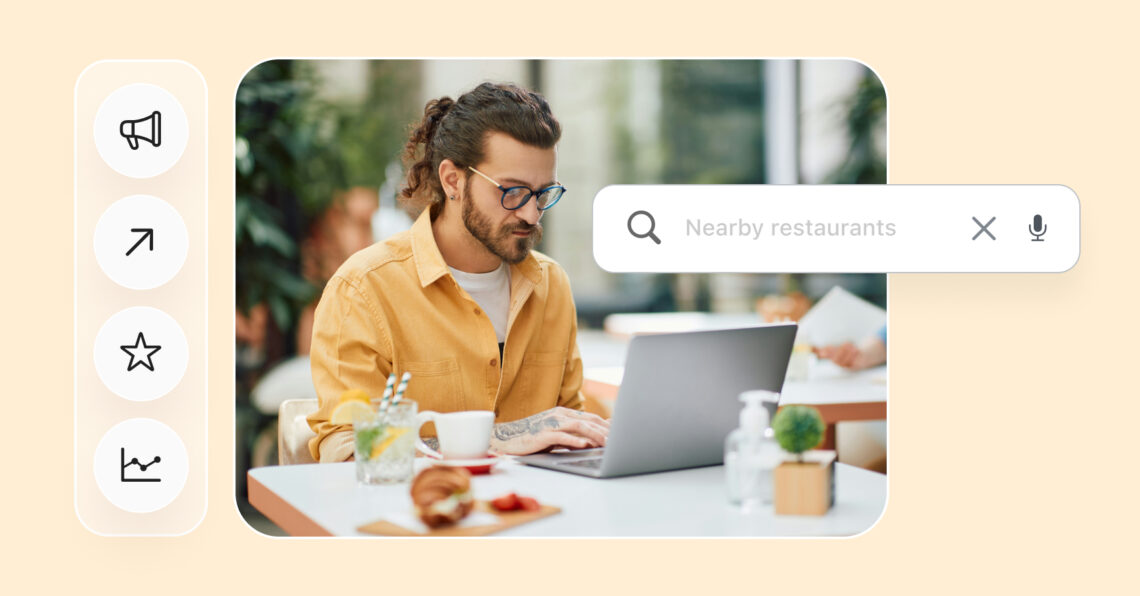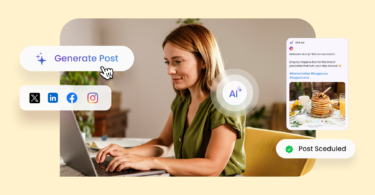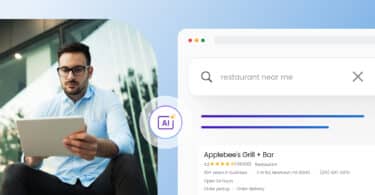Local restaurant marketing isn’t about being the best place in town, but the most discoverable. You could serve the best brisket on the block or host the coziest brunch in the city, but if you’re not showing up where your potential customers are looking—Google Maps, Instagram, or third-party restaurant review sites—you’ll lose out to restaurants with stronger digital visibility.
While chains have entire teams fine-tuning every marketing campaign, many still overlook local store marketing for restaurants—i.e., they rely on outdated playbooks instead. The result? Empty tables, inconsistent foot traffic, and underused digital real estate.
In this blog, you’ll learn 7 ideas for local restaurant marketing—including tools, tactics, a 10/10 checklist, and an example of a famous brand that’ll motivate you to do the same for your brand.
Service tip from the house 💬
Most restaurants don’t fail from lack of effort—they fail from lack of direction. Local restaurant marketing isn’t about trying everything; it’s about doing the right things consistently. This guide is your shortcut to sustainable visibility—with repeatable systems, not one-off ideas. The kind that scales if you’ve got 1 location… or 50.
Table of contents
- What is local restaurant marketing?
- Importance of marketing your local restaurants
- 7 local restaurant marketing ideas
- How Birdeye helps restaurants grow with local marketing
- Score 10/10 with this weekly local restaurant marketing checklist
- FAQs about local restaurant marketing
- Birdeye helps you execute the best restaurant marketing ideas with ease
What is local restaurant marketing?
Local restaurant marketing promotes your restaurant to people within your geographic area—whether they’re new diners searching on Google or locals scrolling Instagram during lunch. It includes a mix of online and offline tactics like optimizing your Google Business Profile, collecting online reviews, building a presence on social media platforms, and partnering with the local community.
What sets it apart from general restaurant marketing is the hyper-targeted intent: It’s not about going viral, it’s about showing up where it matters most—on local search results, maps, and feeds your potential customers already check.
For most businesses, a good marketing plan for a local restaurant begins with three goals:
- Show up in search when someone types “restaurants near me”
- Build trust through positive reviews and authentic engagement
- Create visibility through consistent, location-based content
Importance of marketing your local restaurants
Local restaurant marketing ideas are less about big-budget campaigns and more about smart, repeatable moves that help you show up consistently and convert casually interested diners into loyal customers.
As per Birdeye’s State of Online Reviews 2025 study of 200,000+ businesses, review volume grew by 13% in 2024 alone, and Google now owns 81% of all review activity across platforms. If you’re not actively managing your restaurant’s appearance on Google, you’re not just invisible—you’re replaceable. That’s why local visibility, trust, and consistency are now the front lines of restaurant growth.
But knowing what local restaurant marketing is isn’t enough. The real impact comes from executing it the right way, week after week.
7 local restaurant marketing ideas
When it comes to attracting and retaining local customers, no single tactic does it all. Instead, think of your strategy as a mix of location-first, visibility-focused actions that can be repeated every week. The right combination of restaurant marketing ideas helps you stand out in crowded search results, earn trust before diners even arrive, and build a presence that keeps people coming back.
The goal isn’t to do everything. It’s to consistently do the right things, especially the ones that create visibility, reviews, and real engagement in your neighborhood.
These 7 restaurant marketing tips help build consistent visibility and trust. Here they are:
1. Make your restaurant easy to find in local searches
Most diners don’t find restaurants by name—they search by need. “Best tacos near me.” “Breakfast is open now.” This is where local search becomes your front door. If your business isn’t optimized to show up in those moments, your menu isn’t even in the running.
This is where local SEO for restaurants begins—optimizing your Google Business Profile becomes your best marketing channel. It’s free, visual, and shows up before your website does. This should be your first non-negotiable step for any effective marketing plan for a local restaurant.
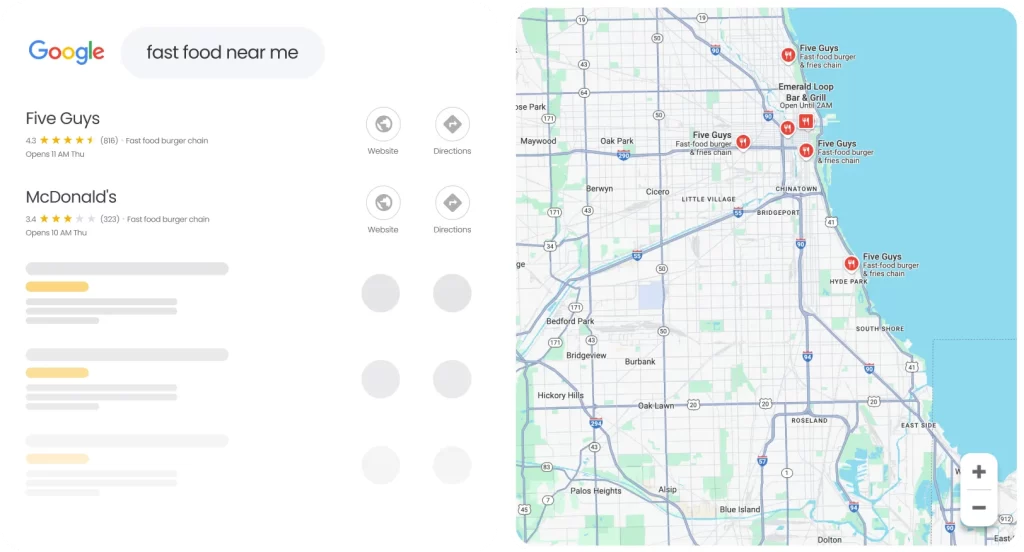
Here’s how to strengthen your local discoverability:
- Claim and verify your Google Business Profile
- Upload high-quality photos (especially of your menu items)
- Add your business hours, contact info, and online menu link
- Use attributes like “outdoor seating,” “takeout available,” or “kid-friendly”
- Add links to third-party delivery services like Uber Eats or DoorDash for easy ordering
- Make sure your listing is consistent across other local businesses directories
Want to go a step further? Tools like Birdeye Listings AI help you sync your information across 50+ platforms and track visibility in real time. That’s how you take full control of your local SEO and start showing up for the right searches—at the right time.
Why this matters locally 🔍
Google now owns 81% of all review activity as per Birdeye's 2025 report (mentioned earlier). That means for every 10 reviews your diners leave, more than 8 are happening right on your Google business listing. If you're not actively managing and optimizing that presence, you're not just invisible—you’re handing opportunities to your competitors.
Once you’re visible in local search, your next priority is building trust, which begins with reviews.
2. Turn glowing reviews into a magnet for new customers
For most diners, your reputation isn’t built on what you say—it’s built on what others say about you. Before they click your website or walk through your doors, they check your online reviews, your average rating, and how (or if) you respond to feedback.
That’s why managing your reviews isn’t just about damage control—it’s a marketing opportunity. After all, reviews aren’t just about credibility—they’re critical for attracting customers actively searching nearby. A steady stream of positive reviews builds trust with new guests, boosts your visibility in local search results, and signals that your restaurant is active, credible, and engaged.
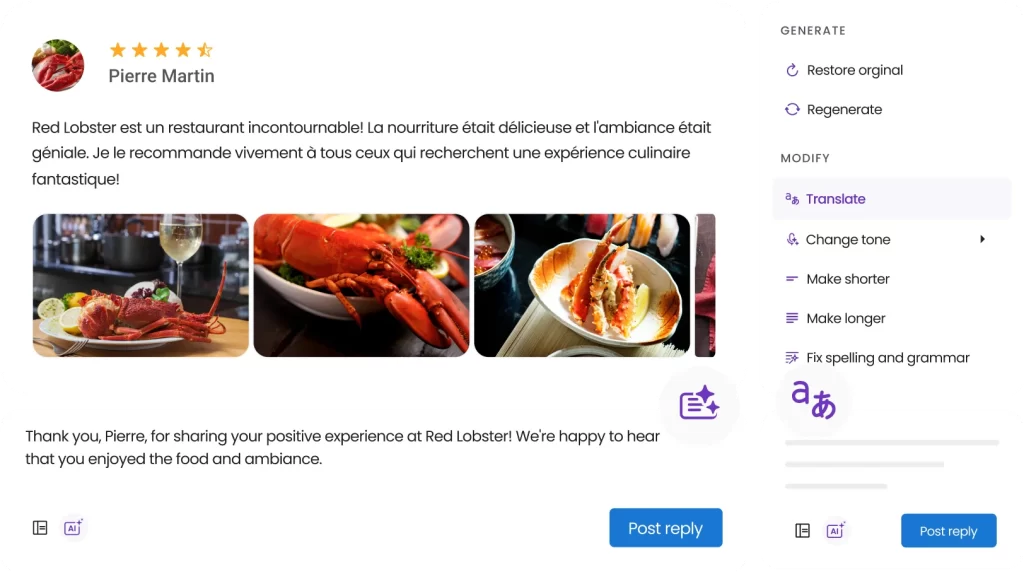
Here’s how to make reviews work harder for your business:
- Ask every diner—don’t wait for the delighted ones
- Use QR codes on receipts or table tents for quick access
- Follow up with a review request via text or email
- Respond to all reviews, especially the critical ones
- Highlight standout reviews in your social media accounts and emails
To scale this, tools like Birdeye Reviews AI help automate requests, track sentiment, and ensure you respond quickly—without manually logging in every day. The result? A stronger review management that works in the background to attract new customers.
3. Engage hungry locals with mouthwatering social content
If your dishes look great on the plate but aren’t showing up in feeds, you’re missing a major opportunity. Social media isn’t just a branding tool—it’s where today’s diners discover, decide, and share. From last-minute lunch plans to weekend brunch cravings, people turn to social media platforms to check photos, peek at ambiance, and see how responsive your team is.
Your content needs to feel real, local, and crave-worthy to reach your target audience, not just polished. That means:

- Sharing behind-the-scenes prep stories and daily specials
- Spotlighting user-generated content from happy guests
- Collaborating with micro food bloggers or creators in your neighborhood
- Running quick polls or Q&As to drive social media engagement
- Featuring customer shoutouts or “dish of the week” campaigns
For local restaurants, this is more than just aesthetics—it’s visibility. Platforms like Instagram and TikTok serve up local posts based on proximity and interactions, so your active social media accounts directly impact who sees you next.
If managing all this feels like another full-time job, Birdeye Social AI helps automate post creation, scheduling, and performance tracking—so you stay consistent without losing hours.
4. Use location-based ads to promote time-sensitive offers
Not every diner is planning days in advance. Many are deciding where to eat right now—on their phones, in traffic, or mid-scroll. That’s where local marketing campaigns shine. Targeted ads on Google, Facebook, and Instagram let you reach people who are nearby, hungry, and ready to act.
Instead of generic ads, lean into urgency and proximity. Here’s how to get more from your marketing efforts:
- Promote a daily lunch special or happy hour deal within a 5-mile radius
- Use Google Ads with keywords like “near me,” “open now,” or “best pizza restaurant”
- Set up geofenced Facebook or Instagram ads for specific neighborhoods or events
- A/B test ad creatives by daypart (e.g., brunch vs. dinner)
- Pair your ads with reviews and menu images to drive clicks
The best part? You don’t need a huge budget. Geo-targeted campaigns are some of the most effective local marketing ideas—especially when paired with a strong restaurant website or online menu that converts clicks into covers.
5. Reward regulars and keep them coming back
Winning a customer once is good. Turning them into a regular? That’s where the real margin is. But repeat customers don’t just return because of great food—they come back because you’ve built a relationship. That’s why loyalty is one of the most underrated pillars in strong and effective marketing strategies.
Creating brand loyalty doesn’t require a complex app or national program for local restaurants. It just needs to feel personal and consistent. Here are a few attraction marketing strategies you can consider to welcome more diners:
- Punch cards or digital loyalty apps with small rewards (e.g., “Buy 5, get 1 free”)
- Text-based VIP clubs that offer insider deals or early access
- Birthday or anniversary emails with exclusive perks
- Surprise-and-delight moments (a free dessert for a 5th visit, a thank-you note)
- Offering rewards for review participation or referrals
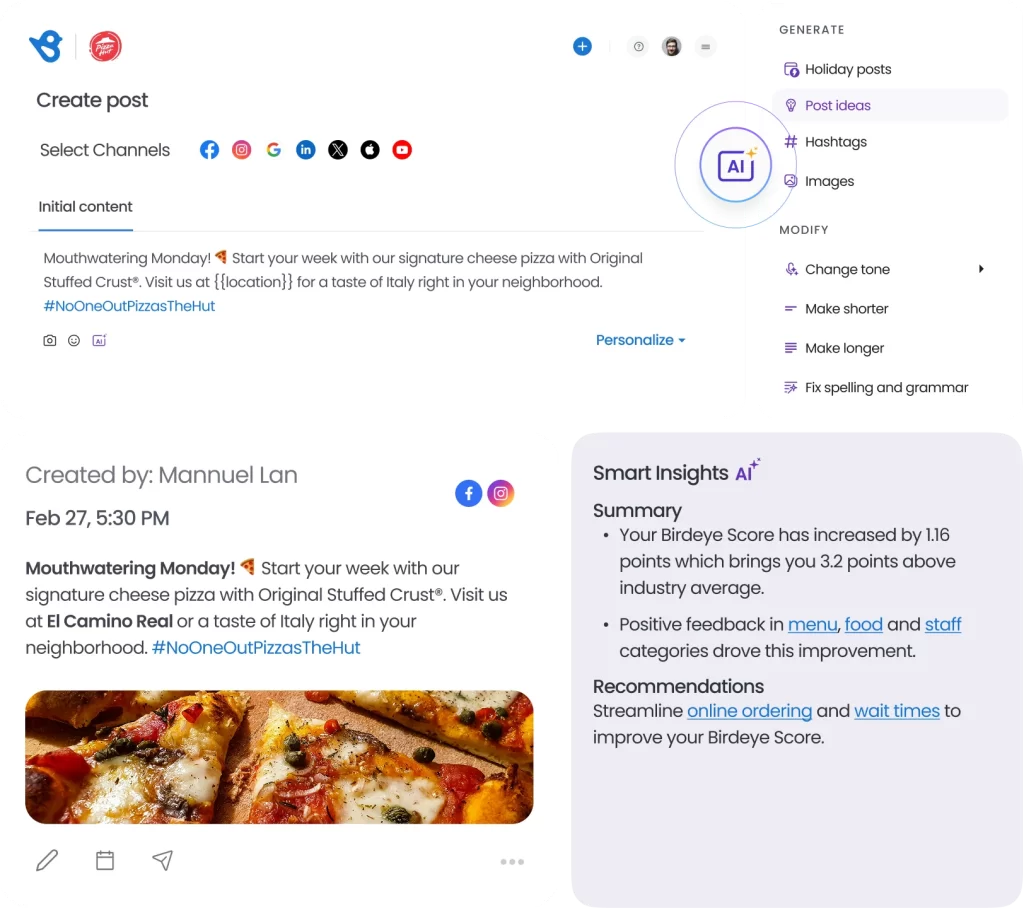
Top ways to track local restaurant marketing performance
Here are 4 key ways to measure local restaurant marketing performance:
- Foot traffic: Use in-store sensors, Wi-Fi check-ins, or POS data to track walk-ins and peak hours.
- Online orders: Monitor order volume from delivery platforms and your website, segmented by channel.
- Customer retention rates: Use your CRM’s loyalty program data or repeat visit frequency.
- Review trends: Track changes in review volume, star ratings, and sentiment to gauge customer experience over time.
With tools like Birdeye Inbox AI, you can automate personalized follow-ups, segment loyal customers, and track engagement across all your marketing channels—so you stay connected without adding manual work.
Retention is good for business and good for visibility. Google’s local SEO algorithm favors businesses that show consistency in search engagement and review activity. A loyal base helps signal that strength.
6. Collect feedback fast — and act on it even faster
Feedback isn’t just a formality—it’s fuel. Whether it’s a compliment on your new pasta or a heads-up about slow service, real-time input from diners helps you adjust quickly and improve the customer experience. For local restaurant marketing, that kind of agility builds reputation and trust faster than any ad campaign.

Rather than waiting for a review days later, invite feedback while the experience is still fresh. Here’s how to do it right:
- Ask short, specific questions like “How was your service today?”
- Offer a small incentive to complete a quick feedback form
- Monitor and respond to negative input quickly to show you care
- Use sentiment insights to train staff or update service flows
- Use QR codes on tables for quick-access surveys
Platforms like Birdeye Survey AI make this seamless. You can automate surveys by time or customer type, and get instant summaries of what people are loving—or what’s slipping. And because these tools are built for speed, you're not just reacting—you’re staying ahead.
Timely action doesn’t just impress your diners—it protects your restaurant’s reputation and helps shape better marketing campaigns over time.
7. Know what your competitors are doing — and do it better
If you’re only tracking your performance, you’re missing half the picture. Your local marketing success doesn’t just depend on how well you execute—it also hinges on how your efforts stack up against nearby competition. Ask if they are:
- Restaurant promotions pulling more engagement?
- Getting more online reviews than you?
- Winning over your local community with better content or offers?
With Birdeye Competitors AI, you can:
- Monitor nearby restaurants’ review volume, ratings, and sentiment
- Track their marketing materials and top-performing social media posts
- Analyze how their brand is perceived across platforms
- Identify content or promo gaps you can fill
- Benchmark your own visibility and review score over time
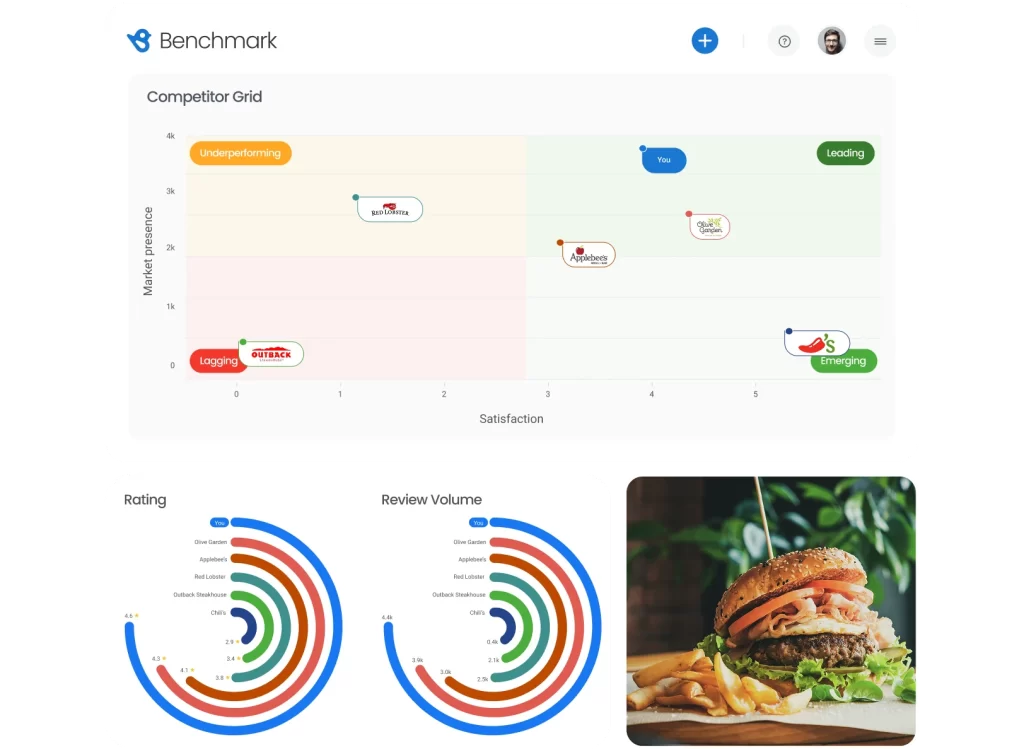
Pair that with Birdeye Insights AI, and you’ll get AI-driven summaries showing where your brand is winning—and where you need to catch up. It’s one of the most powerful marketing strategy tools available for restaurant owners who want to stay ahead.
The key isn’t copying what others are doing—it’s spotting opportunities they’re missing and making smarter moves with the same tools.
How Birdeye helps restaurants grow with local marketing
When running a restaurant, especially across multiple locations, manually managing listings, reviews, social media, and customer feedback is nearly impossible. That’s where Birdeye comes in.
Birdeye is an AI company that is purpose-built for multi-location businesses. It brings all your local marketing under one roof, powered by GenAI tools trained specifically for your industry.
Here’s how it supports your restaurant marketing strategy:
- Listings AI: Keep your Google Business Profile and 50+ directories updated automatically
- Reviews AI: Send review requests, monitor sentiment, and respond—without the manual work
- Social AI: Generate and schedule posts, review engagement insights, and manage your social media accounts
- Inbox AI: Centralize all customer communication and automate responses
- Survey AI: Collect and analyze guest feedback to improve experience
- Insights AI: Track what’s working, what’s not, and how you compare to nearby competitors
- Competitors AI: Benchmark your visibility, reviews, and campaigns against other local businesses
Instead of juggling tools, Birdeye gives restaurant teams a clear view of performance, automation where it matters, and the insights to grow smarter—not just faster.
Case study: How Black Bear Diner mastered local marketing across 150+ locations
What happens when a 156-location chain wants to grow fast, without sacrificing its local feel? Black Bear Diner found the answer. Since opening in 1995, the brand has grown across 13 states and remains one of the most recognized names in the restaurant industry for its hometown feel and loyal following.
The challenge
As Black Bear Diner prepared to double its footprint, it faced critical questions:
- How can we maintain a consistent customer experience across 150+ units?
- How do we manage growing volumes of online reviews, social content, and guest feedback across each diner?
- How do they monitor their restaurant’s reviews and performance?
They needed a marketing strategy that would work across corporate, regional, and local teams, without drowning managers in manual work or risking inconsistent guest engagement.

The solution
Black Bear Diner partnered with Birdeye, a purpose-built AI platform for multi-location businesses. They implemented an integrated solution across locations using:
- Social AI to manage social media accounts, schedule content, and report across all platforms.
- Reviews AI to automate responses and centralize review data.
- Survey AI to collect structured feedback after each visit.
- Insights AI to evaluate sentiment, ratings, and keyword trends.
- Benchmarking tools to compare against other local businesses and track restaurant promotions and performance.
They also adopted automated workflows that created support tickets when negative reviews appeared, helping resolve complaints promptly and preserve their strong online reputation.

The results
- A 4-star average rating across platforms—even with doubled locations
- A scalable, omnichannel digital marketing approach across 150+ diners
- Time-saving tools that empowered GMs and VPs with real-time visibility
- A streamlined search engine optimization strategy via Listings AI and Google Business Profile accuracy
- Deeper customer engagement through automated surveys and content
- Stronger data-driven decision-making using Sentiment Score and Birdeye Score benchmarks
- A centralized dashboard that aligned every content marketing manager and regional lead
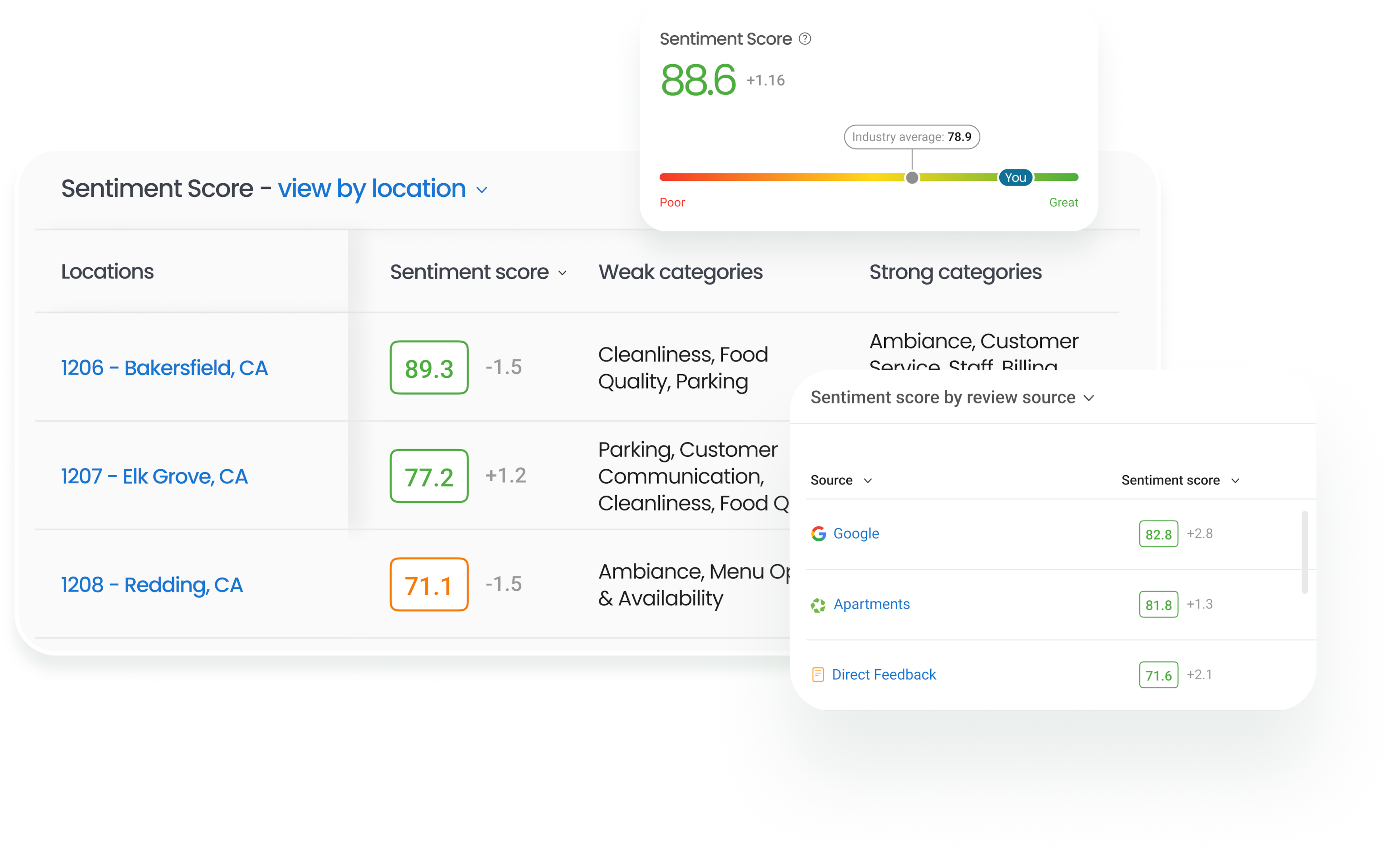
They not only improved operations—they built a strong local following across markets by blending human hospitality with smart automation.
Score 10/10 with this weekly local restaurant marketing checklist
Creative restaurant marketing isn’t about doing more—it’s about repeating what works. This 10-point checklist distills these creative restaurant marketing ideas into weekly actions local restaurants can use to increase their visibility, engagement, and reputation on track week after week.
Whether you’re a restaurant owner doing this solo or part of a growing marketing team, you can use this to build consistency and a strong online presence.
Your restaurant’s local marketing checklist for this week:
- Refresh your Google Business Profile
Add new photos, update hours, and ensure your menu online reflects current specials and prices. - Request at least one review via SMS or email
Use Birdeye Reviews AI or QR codes to encourage user-generated content and fresh online reviews. - Respond to feedback, especially negative reviews, promptly
Don’t just read them—reply to them. Responding shows you care and helps boost local SEO. - Post consistently on your social media platforms
Use trending topics, engage with your social media followers, respond to community mentions, or collaborate with local food influencer marketing accounts. - Run a targeted local promotion
Tie into a local farmers market, school fundraiser, or local events. Highlight the offer in your social and email content. - Engage your local community
Tag or mention community organizations, local sports teams, or partner with other hospitality business-related local organizations on giveaways. - Analyze competitor visibility
Use Birdeye Competitors AI and factor in the relevant keywords to benchmark your restaurant marketing efforts and social traction. - Send a short email marketing campaign
Promote a special, announce a win, or share a staff spotlight. Keep it short, on-brand, and relevant. - Check performance insights
Use Birdeye Insights AI or Google Analytics to find local keywords customers are searching for you in the search engine. - Recognize loyal customers
Cleverly use your marketing resources to repost UGC, share testimonials, and feature a regular, to build trust and show appreciation.
FAQs about local restaurant marketing
It’s promoting your restaurant to nearby diners using tools like Google Business Profile, local SEO, reviews, social media, and locally-targeted campaigns.
Keep your listings accurate, respond to online reviews, and post updates regularly. Tools like Birdeye help you manage these efforts consistently and at scale.
Prioritize review generation, localized content, and email marketing. Collaborate with your local community, run time-bound promos, and monitor competitors to stay ahead.
Birdeye helps you execute the best restaurant marketing ideas with ease
Building a strong presence across your local marketing channels takes more than good intentions—it takes consistency, automation, and insight. That’s exactly what Birdeye delivers.
With Birdeye, your marketing doesn’t just keep up—it compounds. Consistency becomes scale, visibility becomes conversion.
Do you want to see how the best in the hospitality industry stay visible and relevant in 2025?
👉 Book a demo with Birdeye and turn your local restaurant marketing into a growth engine that runs on autopilot.

Originally published
